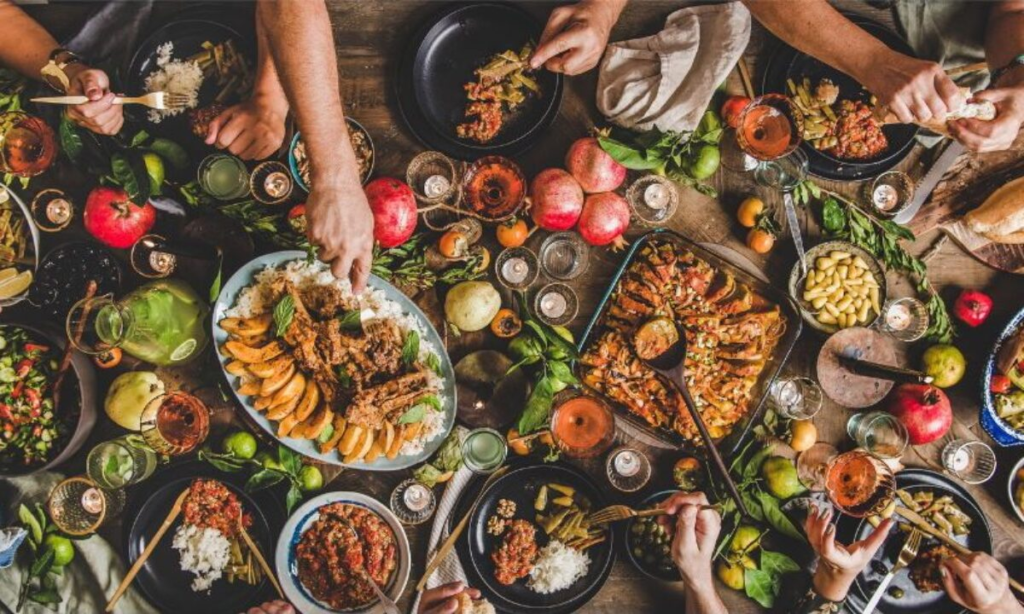In 2025, the food and wine world is going through an exciting transformation. With changing consumer habits, increasing health awareness, and creative innovation in restaurants, Americans are eating—and drinking—differently than ever before. From unusual food combinations to cutting-edge kitchen gadgets and insights from recent health studies, the culinary landscape is becoming more experimental and wellness-driven.
This article explores the most talked-about food and wine trends sweeping the U.S. today.
Health Studies Reshape Eating Habits
Recent studies suggest that Americans are becoming more health-conscious, pushing the food industry to adapt. According to a report published by Harvard T.H. Chan School of Public Health, a balanced diet high in whole grains, fruits, and plant-based proteins can extend life expectancy and reduce chronic illness.

This research has led to a notable rise in plant-forward menus and low-sugar alternatives in restaurants. Chains like Sweetgreen, Panera Bread, and even fast-food giants like Taco Bell are offering low-carb and vegan options to meet this growing demand.
Meanwhile, fermented foods—like kimchi, miso, and kombucha—have been gaining attention due to their probiotic benefits. A recent article by Cleveland Clinic highlights how these foods support digestion and boost immunity.
Weird But Popular: Unusual Food Combos on the Rise
Chefs across the country are experimenting with unexpected ingredient pairings that not only surprise the palate but also go viral on social media.
One standout is the peanut butter and pickle burger, a trend spotted at hip eateries from Brooklyn to San Francisco. It may sound odd, but foodies say the creamy, tangy, and salty combo creates a next-level umami experience.
Another popular trend is ice cream made with savory ingredients like goat cheese, olive oil, or even basil. The result? A refreshing twist on dessert that’s both rich and herbaceous.
For wine lovers, bars are now pairing sweet white wines with spicy Asian street food, a combination that enhances both heat and flavor. Sommeliers are even introducing blue wine—made from a blend of red and white grapes—for its Instagram-worthy aesthetic and surprisingly crisp taste.
These bold experiments show how the boundaries of flavor are being pushed, thanks to adventurous chefs and curious customers.
Kitchen Innovation: Gadgets That Make Healthy Eating Easy
Technology is also transforming home kitchens. In 2025, kitchen appliances are smarter, more compact, and designed for health-focused lifestyles.
The rise of air fryers has continued, but newer models now offer multi-functionality—air frying, grilling, and baking in a single machine. The Ninja Foodi 14-in-1 is a favorite among health enthusiasts who want crispy meals with less oil.
Another trending gadget is the smart blender, like the Vitamix A3500, which connects to your smartphone and suggests smoothie recipes based on your health goals.
Meal-prep robots are even starting to appear in luxury kitchens, capable of chopping, stirring, and even seasoning dishes automatically. This innovation is helping busy families maintain a nutritious diet without spending hours in the kitchen.
Restaurants Embrace Sustainability and Local Sourcing
Sustainability is no longer optional—it’s a key part of a restaurant’s identity. More eateries are choosing local farms and organic producers to source their ingredients. This approach not only reduces carbon footprint but also supports regional economies.

Farm-to-table dining has grown in popularity, with restaurants like Blue Hill at Stone Barns and The Grey in Savannah leading the way. According to Farm Flavor, this trend is helping customers feel more connected to where their food comes from.
Wine producers are also going green. Organic and biodynamic wines are becoming more accessible in U.S. markets, offering cleaner options with fewer additives and sulfites.
Some bars now serve on-tap wine to reduce packaging waste and encourage refillable bottles, proving that even fine wine can adapt to eco-friendly trends.
The Future of Food: Personalized and Interactive
Looking ahead, the next evolution of food and wine will focus on personalization and interactivity. Restaurants are using AI and data analytics to customize menus based on guest preferences, allergies, and even genetic makeup.
Apps like EatLove use nutrition science and personal data to build meal plans for users with specific health goals—diabetic-friendly, heart-healthy, or muscle-building diets.
Interactive dining experiences are also gaining attention. Virtual reality wine tastings, AI-powered food pairings, and holographic menu previews are now part of the luxury dining experience in major cities.
Conclusion: Embrace the Change on Your Plate
The food and wine trends of 2025 reflect a deeper shift in how we eat, cook, and socialize. It’s a world where health, tech, sustainability, and creativity blend to deliver experiences that go beyond the plate.
Whether it’s a burger topped with peanut butter and pickles, a gadget that tracks your vitamin intake, or wine paired with spicy noodles, the culinary world has never been more exciting or inclusive.
And as consumers continue to demand more from their meals—both in flavor and function—the industry is sure to keep evolving. So the next time you step into a restaurant or your kitchen, be ready to taste the future.
Also Read – New Veganism Data Shows What You’re Really Eating in 2025





